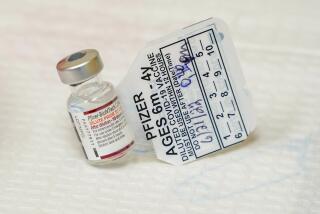Flu spray may protect kids better
- Share via
A nasal spray appears to be more effective than flu shots in protecting children younger than 5, according to a major study published last week.
“It’s good news. We need it, we need a new flu vaccine for children,” said Dr. Neal A. Halsey, director of the Institute for Vaccine Safety at Johns Hopkins’ Bloomberg School of Public Health. He was not involved in the study.
Researchers gave either flu shots or MedImmune’s FluMist nasal spray to almost 8,000 young children in 2004 and found that of the nearly 500 children who caught the flu, those given shots caught it twice as often.
The study, published in the Feb. 15 issue of the New England Journal of Medicine, was funded by MedImmune, which is trying to persuade the Food and Drug Administration to approve FluMist for use by children between ages 1 and 5. Researchers at Saint Louis University School of Medicine say it’s the largest pediatric study ever conducted comparing flu shots with the spray.
But some experts say that because researchers found increased hospitalization rates among the youngest children given the nasal spray, the results warrant closer scrutiny.
“There is an increased risk for certain children, but that has to be balanced against the benefits,” said Dr. Joshua M. Sharfstein, Baltimore city health commissioner. “That’s why we have an FDA.”
Company officials, who have been struggling with competition from injected flu vaccines, called the results good news.
“We’re very excited that these data are now out there,” said Dr. Frank J. Malinoski, senior vice president of medical and scientific affairs for MedImmune.
Dr. Robert B. Belshe, the study’s lead investigator and a professor of medicine and pediatrics at Saint Louis University School of Medicine, said the spray works better in children because it’s a weakened version of live flu virus. Injected vaccine is a dead virus.
“The live vaccine gives a broader response, better than a flu shot,” Belshe said.
Another advantage, he said, is that whereas shots stimulate antibodies in the blood, the nasal spray stimulates antibodies in the blood and the nose.
“Shots are good at boosting preexisting immunity,” he said. “But they don’t work as well where there is no preexisting immunity.”
The FDA approved FluMist for people between ages 5 and 49 in June 2003 but withheld approval for children younger than 5 because of previous studies linking it to wheezing problems among some youngsters.
A refrigerated version of FluMist was approved by the FDA in January and is due to replace the current frozen formula, which has been criticized for having difficult storage requirements.
MedImmune’s hopes to win FDA approval in May to begin marketing FluMist to children ages 1 to 5 with no history of wheezing or asthma, Malinoski said. FDA approval would open up a market of 14 million children now ineligible for the spray, he said.
MedImmune also hopes to one day win approval to distribute the vaccine to adults 50 and older, but has yet to provide the necessary safety data to the FDA.
The study shows FluMist is safe for children ages 1 to 5 who have no history of wheezing or asthma, Belshe said.
But, he said, there is still a need for a safe vaccine for children younger than 1. The study results show that 42 of the infants between 6 to 11 months old were hospitalized within six months of being given the nasal spray, compared with 18 hospitalization cases among infants given shots.
Belshe called the hospitalization rates “puzzling,” and said many of the hospitalized children had problems largely unrelated to flu, such as diarrhea and lung infections. “We don’t understand why that is,” he said.
In an accompanying editorial, the New England Journal of Medicine editors called the results encouraging, but they recommend “further discussion and careful review” of safety data before FluMist is approved for young children.
“They’re simply calling for caution and that’s appropriate,” Belshe said. “We’re talking about a very vulnerable population, children under 5.”
In the study, 7,852 children ages 6 months to 59 months received either the nasal spray or a flu shot at 249 hospitals and healthcare facilities in 16 countries. Those given active doses of the spray also were given placebo shots; those given real shots got a placebo spray. Influenza-like symptoms were then monitored and nasal swab cultures were taken throughout the 2004-05 flu season.
Of the 491 children infected during the ensuing flu season, 338 had been given flu shots and 153 had received nasal spray, which translates into 54.9% fewer flu cases. The spray was particularly effective at preventing the most common of the three strains of flu that cause illness each year, reducing cases of the H3N2 strain of flu virus by 79%.






